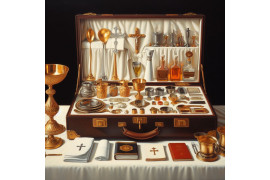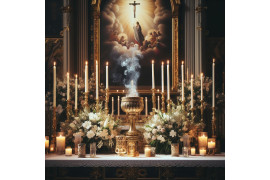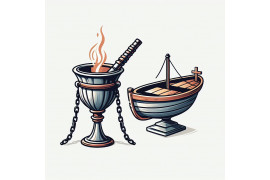The chalice and the communion cup are both significant elements in the sacrament of Holy Communion, symbolizing the blood of Christ. These vessels hold a central role in the ritual, representing the vessel used by Jesus during the Last Supper. While they share similar purposes, there are subtle differences between them that distinguish one from the other.
The chalice typically refers to a larger ornate cup, often made of precious metals such as gold or silver. It is adorned with intricate designs and may have a stem and base. On the other hand, a communion cup is usually smaller and simpler in design, commonly made of glass or ceramic.
Understanding these distinctions can deepen our appreciation for the rich symbolism embedded within this sacred practice.
Regional Variances: Chalice and Communion Cup in UK and North America
In Christian churches, the use of chalices and communion cups can vary depending on the region. Let's explore the regional variances between chalices and communion cups in the UK and North America.
Chalices are commonly used in traditional Anglican and Catholic churches in the UK.
In the United Kingdom, chalices hold significant importance in traditional Anglican and Catholic Church services. These vessels are typically made of precious metals like gold or silver, symbolizing their sacred purpose. The design of a chalice often includes intricate engravings or embellishments, adding to its aesthetic appeal.
The use of chalices is deeply rooted in religious traditions that have been passed down through generations. Their presence during Holy Communion represents a connection to centuries-old rituals and practices. The act of drinking from a chalice is seen as a solemn and reverent gesture, emphasizing the significance of this sacrament.
In North America, both chalices and communion cups are used, with cups being more prevalent in Protestant denominations.
Unlike the UK, where chalices hold prominence across various Christian denominations, North America showcases a more diverse practice. While chalices are still utilized in some churches, communion cups have gained popularity, particularly among Protestant denominations.
Communion cups are typically smaller than chalices and are often made from materials such as glass or metal. They may be stacked neatly on trays for distribution during Holy Communion services. This practical approach allows for efficient administration of the sacrament to larger congregations.
The choice between a chalice or a cup often depends on church tradition and personal preference.
Church tradition plays a vital role. Some churches adhere strictly to long-standing customs that dictate the use of either one vessel or the other. These traditions are often deeply ingrained in the church's history and hold great significance to its members.
On the other hand, personal preference can also influence the choice between a chalice and a cup. Church leaders may consider factors such as symbolism, aesthetics, practicality, and ease of use when deciding which vessel to incorporate into their worship practices.
It is important to note that regardless of whether a chalice or cup is used, the underlying meaning and purpose of Holy Communion remain unchanged. Both vessels serve as conduits for receiving the body and blood of Christ during this sacred sacrament.
Unveiling the Significance of the Chalice in the Christian Eucharist
The chalice, a sacred vessel used during the Christian sacrament of communion, holds deep significance within the religious ceremony. Its design often incorporates religious symbols or intricate decorations, serving as a visual reminder of Christ's sacrifice and presence within the sacrament.
Sacred and Consecrated for Communion Use Only
The chalice is considered sacred and consecrated solely for use during communion. It is not an ordinary cup, but rather a vessel set apart for this specific purpose. This distinction highlights its importance and reverence within the context of the Eucharist.
A Visual Reminder of Christ's Sacrifice
The symbolism inherent in the design of the chalice reinforces its significance during communion. The Last Supper, where Jesus shared bread and wine with his disciples before his crucifixion, forms the foundation of this ritual. In remembrance of that event, churches utilize a chalice to represent Jesus' act of offering his body (represented by bread) and blood (represented by wine) as a sacrifice for humanity's salvation.
Religious Symbols and Ornate Decorations
Chalices often feature religious symbols or ornate decorations that enhance their visual impact during worship services. These elements can include crosses, images of saints, angels, or other representations related to Christian theology. These embellishments serve to deepen believers' connection to their faith and create a sense of awe and reverence during communion.
Connection to Passover Meal
The roots of communion can be traced back to the Jewish Passover meal celebrated by Jesus with his disciples before his crucifixion. During this traditional meal, known as the Seder, participants drink from wine cups called "wine cruets" representing joyous celebration and thanksgiving. In Christianity, this tradition evolved into what we know today as Holy Communion or Eucharist.
The Chalice in Liturgy
The chalice plays a pivotal role in the liturgical practices of various Christian denominations. It is used to hold the wine that represents Christ's blood, which believers partake in as a symbol of their faith and unity with Jesus. During the Eucharistic prayer, the chalice is lifted and presented to the congregation, signifying the offering of Christ's body and blood for their spiritual nourishment.
A Powerful Symbol in Worship
Beyond its practical purpose of holding wine during communion, the chalice holds deep symbolic meaning within Christian worship. It serves as a physical representation of Jesus' sacrifice and his ongoing presence within the sacrament. The act of drinking from the chalice signifies participation in Christ's redemptive work and strengthens believers' connection to their faith community.
Impact of Disease Transmission Concerns on Communion Cup Usage
Outbreaks such as influenza have raised significant concerns about the potential transmission of diseases through shared communion cups. Many people worry about germs and the spread of illnesses in close-knit religious communities. As a result, some churches have started adopting alternative methods to minimize the risk of infection during Holy Communion.
One approach that has gained popularity is the use of individual cups. Instead of sharing a common cup, each person receives their own small cup containing the wine or grape juice. This method ensures that there is no direct contact between individuals, reducing the chances of disease transmission. It provides a sense of personal hygiene and gives peace of mind to those who are concerned about germs.
Another alternative method that churches have embraced is intinction. In this practice, worshipers dip a piece of bread into a common cup containing either wine or grape juice. While this still involves sharing a communal vessel, it eliminates direct mouth-to-cup contact. Some believe that this method strikes a balance between maintaining tradition and addressing health concerns.
The decision regarding which method to adopt often depends on various factors, including health guidelines issued by sanitarians and local health authorities. During times when there is an increased risk of disease transmission, churches may opt for individual cups or modify their practices accordingly.
Pros:
-
Individual cups reduce the risk of disease transmission by eliminating direct contact between individuals.
-
Intinction allows congregants to partake in Holy Communion while minimizing the chances of spreading germs.
-
These alternative methods provide reassurance to those who are concerned about their health during religious ceremonies.
Cons:
-
Some argue that using individual cups or practicing intinction deviates from traditional practices and diminishes the symbolic significance associated with sharing from a common chalice.
-
Implementing new methods may require additional resources and logistical adjustments within church communities.
It's important to note that these changes in communion practices are not solely driven by disease concerns. The shift towards individual cups and intinction has also been influenced by the evolving understanding of germ theory and advancements in sanitization practices. Unrefrigerated shelf life is a factor to consider when deciding which method to adopt.
Risks and Benefits of Shared Communion Cups
Risks of Disease Transmission
Shared communion cups can pose a risk of transmitting germs between individuals. When multiple people drink from the same cup, there is a potential for saliva, bacteria, or viruses to be transferred from one person to another. This can increase the likelihood of spreading illnesses, especially in situations where someone may unknowingly be carrying an infectious disease.
While it is not common for diseases to be transmitted through shared communion cups, it is important to recognize that the risk exists. Certain illnesses, such as colds, flu, or even more serious infections like COVID-19, can potentially be passed on through close contact and sharing of objects like communal cups.
Symbolism of Unity
Despite the potential risks associated with shared communion cups, they also symbolize unity among believers who partake from a common vessel. The act of drinking from the same cup represents a shared spiritual bond and solidarity within a religious community. It signifies that all individuals are equal in their faith and connected through their belief system.
For many religious traditions, using a shared cup during communion holds deep symbolic meaning. It reinforces the idea that all members are partaking in the same sacrament and are united in their devotion to their faith. This sense of unity can foster a strong sense of community and belonging among worshipers.
Mitigating Risks through Hygiene Practices
To mitigate potential risks associated with using shared communion cups, proper hygiene practices should be implemented. Religious institutions can take steps to ensure the safety and well-being of their congregants while still maintaining the symbolism and significance of communal worship.
Here are some recommended hygiene practices:
-
Regularly clean and sanitize the communal cup between uses.
-
Wipe or rinse the cup with water or disinfectant after each individual's use.
-
Encourage individuals who feel unwell or have symptoms of illness to refrain from participating in communion.
-
Provide alternative options, such as individual cups or pre-filled cups, for those who may have concerns about sharing a communal cup.
By implementing these hygiene practices, religious communities can help reduce the risk of disease transmission while still preserving the symbolic value of shared communion cups.
Summarizing the Distinctions between a Chalice and a Communion Cup
In summary, this blog post explored the differences between a chalice and a communion cup. It discussed regional variances in their usage, highlighting how the terms are commonly used in the UK and North America. The significance of the chalice in the Christian Eucharist was unveiled, shedding light on its symbolic nature and historical importance. The impact of disease transmission concerns on communion cup usage was examined, emphasizing the need for caution and alternative practices. Finally, the risks and benefits of shared communion cups were analyzed to provide a comprehensive understanding.
To ensure you make an informed decision regarding your choice of vessel for sacramental purposes, it is crucial to consider factors such as tradition, symbolism, hygiene, and safety. Whether you opt for a chalice or a communion cup depends on your personal beliefs, cultural background, and local customs. It is recommended that you consult religious leaders or experts in your community who can provide guidance based on these considerations.
FAQs
Are chalices only used by specific Christian denominations?
Chalices are primarily associated with Christian traditions that observe sacraments such as Holy Communion or Eucharist. While they are commonly used by various denominations within Christianity (such as Roman Catholicism, Eastern Orthodoxy, Anglicanism), other Christian groups may have different practices or use alternative vessels.
Can I use any type of cup for communion?
While some churches may allow flexibility in choosing vessels for communion purposes, many adhere to specific requirements based on tradition and symbolism. It is advisable to consult your church's leadership or follow established guidelines to ensure that you respect the significance of this sacred ritual.
How often should communion cups be cleaned?
The frequency of cleaning communion cups varies depending on individual church practices. However, it is generally recommended to clean them thoroughly after each use to maintain hygiene and prevent the spread of germs. Regular sanitization is essential to ensure the safety of all participants.
Can I use disposable communion cups?
Disposable communion cups are a viable option for churches or individuals concerned about hygiene and ease of cleaning. These cups are designed for single-use, eliminating the need for washing and reducing the risk of contamination. However, it is important to consider environmental implications when choosing disposable options.
What materials are commonly used for chalices and communion cups?
Chalices and communion cups can be made from various materials such as precious metals (gold, silver), pewter, glass, ceramic, or even food-grade plastic. The choice of material often reflects cultural traditions, personal preferences, and considerations regarding durability and maintenance.



